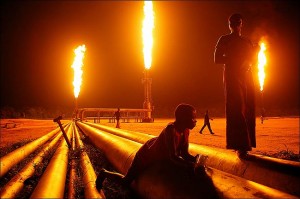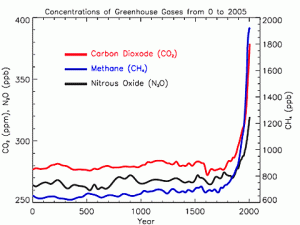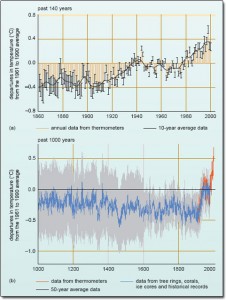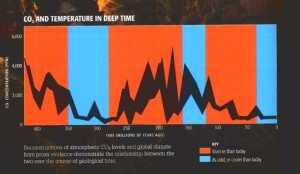Arguing with a global warming skeptic in a dance club was extremely frustrating. It would not have been my first choice of venue to entertain such a complicated discussion. As an environmental activist, I feel that it is important to try to convince even the most skeptical people of the upcoming plight that humanity will have to manage. But as you may have guessed it was difficult to reach any consensus between the the unsupported arguments and thumping hip-hop beats. He subscribed to the belief that all of the evidence published in the media was part of a large conspiracy. When I mentioned many reputable sources he listed just as many obscure sources that contradicted my claims. He placed a large confidence in his observation of cooling local weather patterns. At the time I was too muddled and unprepared to respond. Thankfully, the decision makers that will attend the Kyoto 2 Conference in Copenhagen in December have largely acknowledged the complexity of global climate change more than the clubber skeptic I ran into. There is a need to look beyond our local experience (which may or may not reflect the global trend of warming) and recognize that it is not just “global warming” that we are dealing with, but “global climate change.”
The term “Global Warming” has too narrow a definition to be a useful because there are a whole host of other climactic and ecological changes linked with anthropogenic climate change that may have different, but no less significant consequences as is described in the What’s in a Name? Global Warming vs. Climate Change article on the NASA website. International institutions and governments have adopted the term “climate change”, which reflects a a commitment to recognizing the multiplicity of issues involved.
There are so many complexities within and between the cryosphere, biosphere, hydrosphere, lithosphere, and atmosphere that it is important to consider all of these issues when discussing global climate change. Also, it can be difficult for scientists to collect enough of the right type of evidence sufficient for convincing all of the clubber skeptics out there of the tremendous problems occurring to the aforementioned systems on a global scale. It is easy to understand how there are people like the clubber skeptic from all walks of life who do not take climate science seriously enough and are deceived by political deception. Because we are unable to directly measure environmental systems from the past, scientists have developed indirect methods for collecting indirect or “proxy data” on the former temperature and green house gas concentrations using some of the following techniques: 
These methods have flaws, but hopefully better methods will be developed in the future. Joseph Bump et al. suggests an alternative to tree rings in his Stable isotopes, ecological integration and environmental change: wolves record atmospheric carbon isotope trend better than tree rings. Despite their flaws, the current proxy data are useful, because they can be incorporated into models, which can be used by politicians and disseminated to the public through the media. If I had given the clubber skeptic any evidence that anthropogenic activities were causing global climate change I would have first and foremost been a dork for bringing it to a club, but if I had known of my need for evidence and been willing to commit social suicide I would have brought evidence including some of the following:
- Green house gas levels (source: IPCC AR4 Synthesis Report)
- The increases in recent periods of wild fires
- Sea Level Rise
Data and data analysis like this are imperfect and constantly being updated and expanded upon. The earths systems are too complex for all of the consequences surrounding global warming to be quantified. However, we cannot deny its existence through localized experiences, because there is so much fluctuation globally and locally that one must look at the overall trends as is illustrated in this graph from the IPCC AR4 Synthesis Report.
Therefore, need to spread this type of data more thoroughly amongst the general public and agree to abide by the precautionary principal. This is because there strong evidence from the past that the earths systems are responding to human induce climate change and that the consequences will be more severe than a global tan. The clubber skeptic has been warned!
Tags: climate change, climate change education, COP15 Resources, Philip Rothrock, skeptic clubber
As many skeptics of global warming argue, the world’s climate does in fact change, has been changing since the beginning of time. However, as scientific research has improved, we can see that there has been a dramatic increase of carbon dioxide (CO2), the main and most abundant GHG that is believed to cause global warming, in our atmosphere today than has been recorded in over 1000 years. What evidence is evidence that humans are a significant cause of the recent changes in climate? Simply put, the primary factor of human impact on global climate change is the recent increase of fossil fuel burning, which use has been relatively increasing since the industrial revolution. Additionally, other greenhouse gases (GHG) are produced by human activity, such as agriculture, which is the source of nitrous oxide (N2O), and more specifically, rice cultivation, which produced methane (CH4). According to “Dire Predictions” Mann and Kump state that “these human sources have increased the flow of N20 into the atmosphere by 40-50% over pre-industrial levels” further proving that humans have an impact on Earth’s climate (27). They also state that decomposing refrigerators and stoves that were banned because gases produced during its use were causing ozone layer depletion are still leaking these dangerous gases, which continues to contribute to the hole in the ozone layer above Antarctica. These gases, known as CFCs, are very strong GHGs, and contribute to climate change. The increase in GHGs are correlated to the rise in global and oceanic average surface temperature, which have been progressively increasing since the industrial revolution. Moreover, the changes in oceanic temperatures, and phenomenons such as El Niño, and La Niña, have had a great affect on our climate. Mexico has been suffering from severe drought due to the El Niño affect. The rise in oceanic temperatures caused by GHG affects, have caused and increase in amount and in intensity of tropical storms, hurricanes, and cyclones. Evidence of this is the 2005 disastrous hurricane season, which three category 5 hurricanes hitting the U.S, and the tropical storm that has recently devastated the Philippines, killing at least 86 people, and leaving almost 80% of the country flooded. There has also been a major dust storm in Australia, that usually occur inland but has effected the coastal city of Sydney. With the drastic increase of these natural disasters, I do not understand how people continue to be skeptical about global warming. What is it going to take for policy makers to feel enough urgency to act more efficiently and effective about changes we as a country, as well as a global community need to make to help prevent even more disastrous events from occurring?
Tags: and tropical storms, climate change, cyclones, Drought, floods, human-induced, hurricanes, increase in natural disaters, student-citizens
LET IT BE KNOWN—humans have had an increasingly significant role in changes to the Earth’s climate. But really, how could we not? With industrialization and development, lifestyles/cultures that favor individualism and consumerism, and an increasing populace demanding their share of the energy sector—all within the past few hundred years—how could changes not take place?

Source- NY Times
Indeed, changes in climate can be measured in a number of ways, perhaps most prominently through releasing of CO2 when fossil fuels like oil and coal are burned for energy. Graph 1 clearly shows a spike in atmospheric greenhouse gasses occurring around 1750, the start of the Industrial Revolution. This rise of GHG concentrations corresponds to the increase in temperature changes observed over the past millennium (Graph 2).

Graph 1- Atmospheric Concentrations of GHG

Graph 2- Temperature Changes Over the Past Millennium
Moreover, since this important revolution mass production and consumption have become the cornerstones of industry and society. Massive (rather than sustainable) agriculture production, deforestation, and other land use practices can also be attributed to this. But above all, it is our reliance on fossil fuels and our lack of sustainable practices within the energy sector that have gotten us into this mess (Take a minute to view the introduction of “Energy Crossroads: A Burning Need to Change Course)
The fact of the matter is that the natural impacts on the climate (changes in solar output, explosive volcanic activity, and some of the positive feedback loops) have not been nearly significant enough to account for all this change. Rather, it has been the impact of humans driving climate change. As a result, we will face more severe droughts, floods, and storms and changes to our environment in the future.
A former professor of mine once said “certainty and science never go together.” He described science as always being tentative and falsifiable. In a discourse where one is limited to the continuous and speculative process of hypothesizing about theories and conducting experiments, it is very difficult to truly prove anything. So scientists give confidence levels and work in shades of gray. But this inherent disadvantage in science has not prevented simple and significant societal changes from occurring. People are aware that smoking is bad for you. The importance of sleep is stressed especially amongst adolescents. Individuals and countries are cautious about nuclear energy. After all, common sense often prevails. With that said, I hope the evidence above is enough to convince others that humans are a significant cause of recent changes to the climate.
Tags: climate change, human-induced, sustainable development
“Although scientists acknowledge that uncertainties exist in our knowledge of global warming, the source of the carbon that has led to the recent buildup of atmospheric carbon dioxide [anthropogenic sources] isn’t one of them.”
-Mann & Kump, Dire Predictions p. 34

In a time when climate change information is so readily available (and scientifically linked to human activities), I often ask myself how so many people can deny it. Surely no one looks forward to the predicted effects of global warming in happy anticipation, so what makes these people tick?
Mann and Kump propose that skeptics attribute global warming to natural flucuations. The attribution is logically desirable: if changes are natural, mankind doesn’t have to change anything. Yet, even this argument is based in flawed logic. Humans weren’t around the last time temperature trends were so high; dinosaurs were. The Earth will continue to spin, yes, but will humans have tickets to the Tilt-a-Whirl? It’s hard to say.
So what can make U.S. citizens continue deny global warming? My answer is two-fold:
1) A Flawed View of Wilderness – William Cronon argues that our view of wilderness as removed from mankind is flawed. If were are removed from nature, then it follows that we cannot affect it from our suburban homes. The idea is a dangerous one because it denies the linkage between human activities and the environment for purely Romantic reasons. Yes, sitting by a tree and writing a poem about it is nice, Wordsworth, but it doesn’t mean that mankind is removed from the natural order. In fact, Cronon argues that it is precisely this romanticism that is the problem: Nature with a capital N is a man-made construction.
2) Democracy – The 2nd answer (and coincidentally the 2nd worst form of government in Plato’s Republic) follows directly from the first. If we see Nature as it appears to be (removed, unalterable), as opposed to how it actually is (alterable, our responsibility) then we as a democratic society will act incorrectly. And even if we changed our view of Nature (so that everyone had a vast philosophical understanding of it) even then we would act selfishly instead of correcting the problem. Socrates argues that citizens of democracies will be ruled by their desires alone, allowing wisdom to fall to the wayside (funny that he predicted the United States in ancient Athens.) When ruled by desires (more money, land, material possessions) it’s easy to see the thought processes: will solving global warming hinder my acquisition of stuff? Yes. Then I’d rather not solve global warming.

The Republic
More problems with democracy:
1) Diffusion of Responsibility – In large groups (such as forms of government) individual responsibility is diffused according to this psychological tenant. Unlike an aristocracy, timocracy, oligarchy, et cetera, in a democracy the responsibility to make sound choices rests in a large group (the people), and so people can more easily serve their desires when they have no personal responsibility to solve the problem.
2) Speed of Decisions – Because decisions are made based upon a consensus of very large groups (and these groups consist of people whose choices get them re-elected) the speed of the decision-making processes in democracies is comparatively slow to other forms of government. And with an issue as pressing as global warming, we need to make decisions more quickly. Mann and Kump explain that it takes hundreds or thousands of years for a net removal of a single carbon dioxide molecule from our atmosphere — so we cannot afford to continue at our present rates of consumption for much longer without ruining the next hundreds or thousands of years!
We need change and we need it fast.
We need to recognize that we are an integral part of Nature.
We need to recognize that we are the principal cause of global warming.
We need to recognize that we have the ability to stop global warming before we go too far.
We need to recognize that we must act quickly.
We need to recognize that it is everyone’s shared responsibility.
-Brett

Change We Need!
Read articles more on Democracy by Brett Shollenberger
Tags: climate change, democracy, philosophy, wilderness
 Weather patterns are on the fritz all around the world. Georgia is being inundated with rain, Tropical Storm Ketsana is causing intense flooding in the Philippines, Kenya is in its third year of severe drought… is this climate change?
Weather patterns are on the fritz all around the world. Georgia is being inundated with rain, Tropical Storm Ketsana is causing intense flooding in the Philippines, Kenya is in its third year of severe drought… is this climate change?
Although similar and very much related, there is a distinct difference between “climate” and “weather.” The key difference is time. Weather refers to the way the atmosphere behaves in a short period of time- days, weeks, and months. We often think of weather in terms of its effects upon our day-to-day lives. Climate on the other hand, is the average of weather patterns throughout time and across space. In this way, climate is rather predictable- it’s the weather we expect for a given place at a given time of year.

Ice Core Sampling
Geologists have established an impressive record of ocean and atmospheric temperatures, spanning millions of years. By extracting air bubbles from ice cores, scientists (geologists, biologists, biochemists, soil scientists… the list goes on) have also created an array of corresponding CO2 concentration levels. What we see is a strong correlation between CO2 levels and temperature- namely, as CO2 levels rise, Earth warms; as CO2levels fall, temperatures fall and Earth cools. Geologists estimate hundreds of millions of years ago, the atmosphere contained as much as 4,000 ppm (parts per million) of CO2. That number is astronomically high when we think of the upper 300-ppm limit we are trying to maintain today. So what do these numbers tell us?
Scientists use “climate sensitivity” measurements to determine the potential magnitude of future global warming. Climate sensitivity measures the extent the planet will warm in response to future green house gas emissions. Often this term refers to the expected temperature change in response to a doubling of pre-industrial atmospheric CO2 concentrations.
Evidence from the “Last Glacial Maximum“, 21,000 years ago, show CO2 levels to be about 50% of what they are now. Sea levels were about 100 meters lower, and vast ice sheets covered the northern hemisphere. Carbon Dioxide concentrations were about half of what they are today, and compiled data indicates that average global temperature was about 5° C cooler. Using this information scientists determined that the equilibrium climate sensitivity for that time period was 2.3 -3.7° C.

Single Pore on Fern
To determine how the Earth may respond to even higher levels of C02, scientist must look further back into deep planet history. Because there is no direct way to measure atmospheric CO2 levels hundreds of millions of years back, scientist have developed proxy measure, such as pores on fossil leaves, to estimate CO2 concentrations.

"CO2 and Temperature in Deep Time" From: Kump and Mann. "Dire Predictions:Understanding Global Warming" 2008. pg. 84.
The graph, “CO2 and Temperature in Deep Time” depicted on page 84 of Dire Predictions shows scientific estimates of climatic pattern for the last 400 million years. CO2 levels throughout the last 400 million years ago were often incredibly high, twice reaching concentrations over 4000 ppm. Warm eras and cool eras paralleled the rise and fall of CO2 levels very closely. In comparison to past periods of time, our current climate is relatively cool and history would suggest we are due for a warming.
Climate change of the past is reconfirming what science of the present clearly shows; CO2 levels are increasing dramatically, as they do the climate is warming. And with that warming comes changes in precipitation patterns, temperatures, and extreme weather events around the world. While the recent weather patterns in Georgia, Kenya and the Philippines cannot be entirely pinned on climate change, they are certainly signs that things are changing.
Tags: climate change, Danielle Hoffman, historic climate change, weather


Your Comments